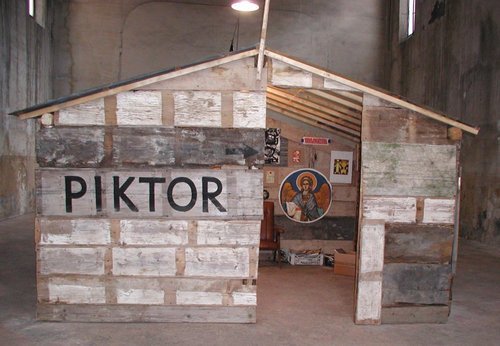Adrian Paci
dal 17/4/2008 al 14/6/2008
Segnalato da
17/4/2008
Adrian Paci
Kunstverein Hannover, Hannover
Paci's work deals with subject matters such as migration, globalisation, and cultural identity in seductively simple archaic images: the choice of media - video, installation, painting, or sculpture - seems secondary next to the desire to counter a complex social present with images that incise themselves on the retina. The exhibition gathers works from all the artist's creative phases since 1997 that deal with the topic of biographical, cultural, and national identity.

The exhibition of works by the Albanian artist Adrian Paci (born 1969) at the Kunstverein Hannover offers multi-facetted insights into his entire oeuvre since 1997. His laconic and poetic studies of everyday life encompass themes dealing with individual, national, and cultural identity. In these works, Paci examines the personal and societal consequences of socio-political upheavals. In the process, his works amalgamate into iconic images that function equally on an aesthetic and political level. Employing a reduced visual language, they mirror the existential feeling of loss and fragility in human existence. Paci’s own biographical background, his emigration to Italy in the late nineteen-nineties, forms the starting point of his works. He has produced numerous videos, installations, sculptures, paintings, and photographs since then which, especially in recent years, have taken leave of a field of the autobiographical in favor of formulations regarding generally valid archetypes. Paci has enjoyed international attention at the very latest since the presentation of his video Turn on in conjunction with the Venice Biennale and his 2005 solo exhibition at P.S.1 MoMA in New York.
In his first video entitled Albanian Stories (1997), Paci’s three-year-old daughter tackles her fragmentary recollections of emigration from Albania with carefree abandon in front of a live camera. In its emblematic simplicity, the moving as well as disturbing narrative in the form of an animal fable already points well beyond the biographical occasion.
The reconstructed life story of the figure Klodi (2005) also veers between the tension poles of tragedy and play. In it, an acquaintance of Paci’s reports on his odyssey, triggered by political and economic conditions, that took him from Albania to Italy, Mexico, the United States and back again. The search for the Promised Land is at the same time an equally oppressive mirror image of current affairs as well as the prankish staging of an exceptionally gifted show off.
Questions dealing with artistic self-conception and autobiography are at the center of Believe me I’m an artist (2000) and the installation Piktori (2002). Piktori documents the work of a painter living in Albania who earns his living by forging documents, copying artworks, and painting signs. For the artist now living in Milan, the death certificate commissioned by Paci paradoxically symbolizes the start of a new life and is expressly characterized by his Albanian colleagues as a masterpiece.
In Per Speculum (2006), Paci filmed the supposedly carefree play of children in the hills of Southern England through a mirror. The idyllic (mirror) image only gradually begins to totter.
The fiction of an ideal children’s world is questioned in the moment in which the mirror shatters into pieces after being shot at with a slingshot at the very latest. The melancholic fragility of the final scene, in which the children sit in the branches of a plane tree and reflect the sunlight with the fragments of the mirror, can only rudimentally alleviate the fundamental brokenness.
Paci’s most recent film, Centro di Permanenza temporanea (2007), was made in California and will now be shown for the first time in a European institutional setting. A mute line of people patiently moves towards the steps of an airplane and comes to a standstill while climbing it.
The Latin American workers fix their gaze expectantly on the camera. It is only when the close-up shifts into a long shot that one realizes that the overfilled gangway leads to nothing. The contrast between the largely motionless people and the planes taking off in the background creates an image of existential abandonment and endless waiting which Paci–as a sculptural placement and political statement–regularly restages from various vantage points.
In addition, the Kunstverein will present further site-specific video installations and photographs as well as two new painting cycles that pictorially reinterpret main works of Italian Neo Realism by Pier Paolo Pasolini.
A catalogue and an edition will be published in conjunction with the exhibition.
Adrian Paci, edited by Martin Engler, Kunstverein Hannover; with texts by Martin Engler und Stefan Çapaliku, hardcover, 29 x 24 cm, 96 pages, 110 illustrations, bilingual (German/English) 25 €/for members 20 €
Immagine: Piktori, 2002
Artist talk Saturday, April 19, 6 p.m.
Curator’s tours Dr. Martin Engler Wednesday, April 23, 7 p.m.
René Zechlin Wednesday, June 11, 7 p.m.
For further information and picture material please contact Ute Stuffer at presse@kunstverein-hannover.de / Tel. 49.511.324594.
Opening: Friday, April 18 at 8 p.m.
Opening: friday, april 18 2008, 8 p.m.
Kunstverein Hannover
Sophienstrasse 2 - Hannover



